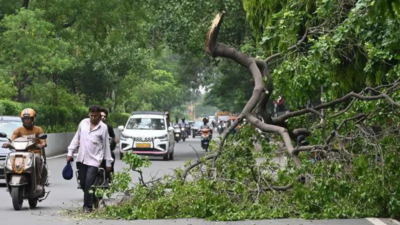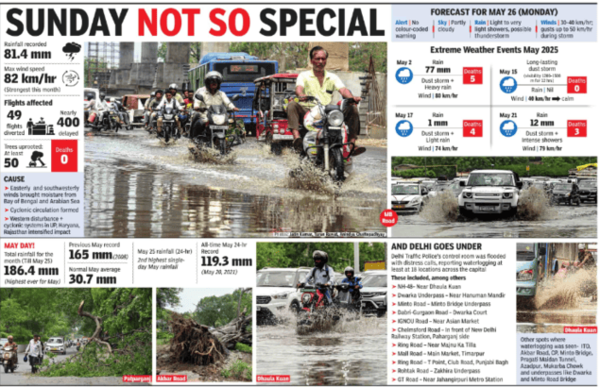Delhi Weather: High temperature, humidity, wind and western disturbances make it a relentless month | Delhi News

NEW DELHI: The fierce storm that struck late Saturday night into early Sunday marked the fourth severe weather event to hit the city in May, officially making it the wettest May ever recorded.

This series of storms has been driven by excessive moisture and recurring cyclonic circulations, creating hazardous conditions across northern India.The intense weather disturbances occurred on May 2, 17, 21 and 25, each time were accompanied by fierce winds blowing at speeds between 74 and 82km per hour. Additionally, on May 15, a powerful dust storm swept through the city with wind speeds of up to 40 km/h, even though no rain fell. This event severely impacted air quality, adding another layer of difficulty to the already extreme conditions.This month’s storms have had tragic consequences, claiming at least 12 lives. The fatalities have largely been attributed to incidents such as falling trees, collapsing walls and the toppling of infrastructure, such as street light poles. Meteorologists have pointed out that such a frequency of violent storms is highly unusual, with an increase in triggering elements—particularly western disturbances—being the main cause of the unpredictable weather patterns observed this season.“Western disturbances have been more frequent in May than in previous years,” explained Mrutyunjay Mohapatra, director general of meteorology at India Meteorological Department (IMD). “As these disturbances pass over northwest India, they influence large areas of the northern and eastern parts of the country. Thunderstorms in summer are not new—they occur every year—but their frequency and intensity have increased this season.When temperatures rise, so does atmospheric humidity, especially in the presence of these western disturbances. For severe thunderstorms, we need high temperature, high humidity, wind and a triggering mechanism like a western disturbance. All of these are currently present. If such trends continue, it could indicate the growing impact of climate change.”Western disturbances are low-pressure weather systems that draw moisture from the Mediterranean and move toward India. They often bring pre-monsoon and winter rainfall, but their increased frequency and interaction with other weather systems have led to more volatile and damaging weather this year.Among the four major storms this month, the one on May 25 was the most powerful. Wind speeds at Safdarjung peaked at 82 km/h. IMD officials noted that this storm was intensified by the presence of an active western disturbance, which had been missing in earlier events.According to a senior IMD weather scientist, the storm developed as moisture-laden easterly and southeasterly winds from the Bay of Bengal, along with southwesterly winds from the Arabian Sea, converged in the lower troposphere over northwest India. Their interaction with mid-level dry winds from the north created the perfect conditions for a severe thunderstorm. In addition, multiple cyclonic circulations were present across the region, including over north Punjab, Jammu & Kashmir, northwest Uttar Pradesh, Haryana and West Rajasthan. The combination of these systems triggered the violent weather on Sunday.Weather analyst Navdeep Dahiya also noted in a post on X that the storm originated over north Punjab due to this interaction and gradually moved toward the Delhi-NCR region via Haryana, bringing with it heavy rain and strong winds.Mahesh Palawat, vice-chairman, meteorology and climate change, Skymet, added: “This May, western disturbances have frequently appeared as cyclonic circulations over northwest India, particularly affecting regions such as Punjab, Haryana and central Pakistan. High temperatures, combined with these circulatory systems, have led to increased moisture. This has contributed to the formation of thunderclouds, especially during late evening hours, which are the primary cause behind the violent dust storms, thunderstorms and bouts of heavy rainfall observed throughout the month.“




